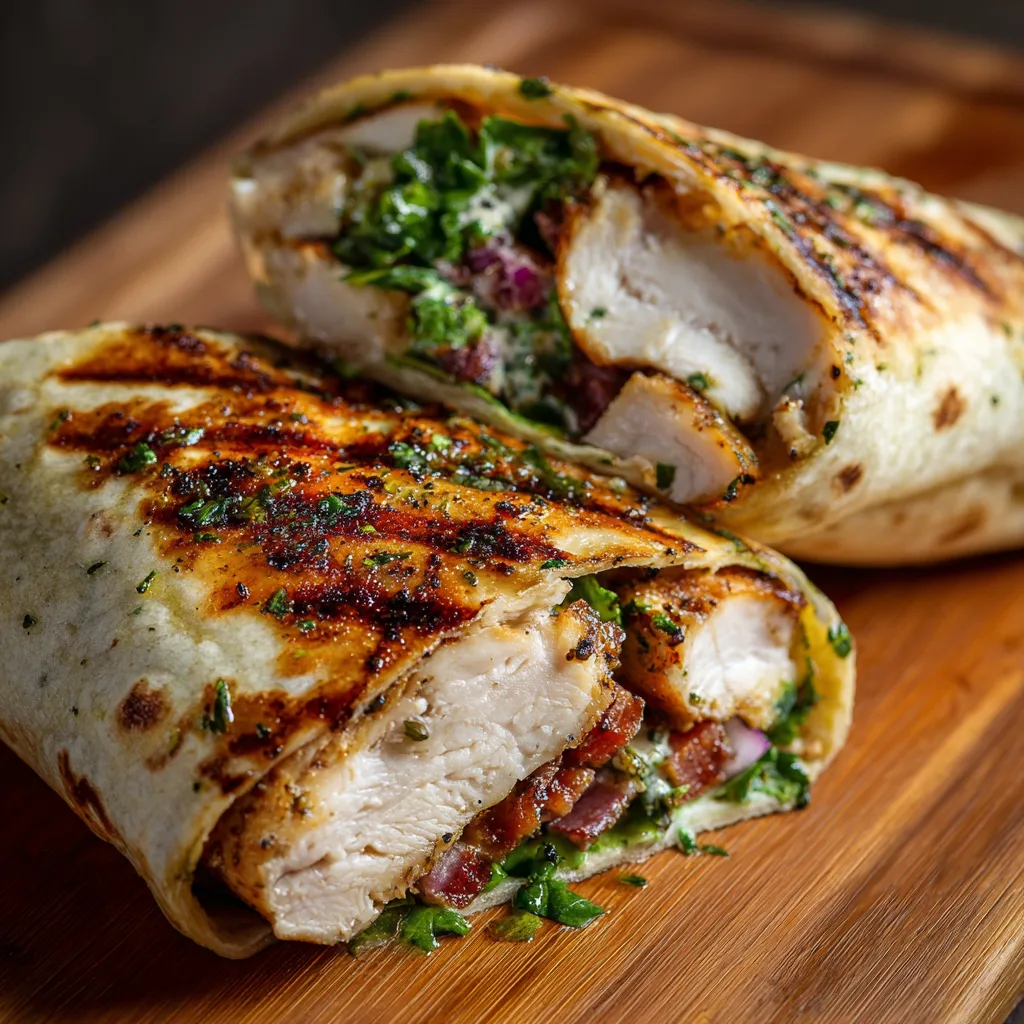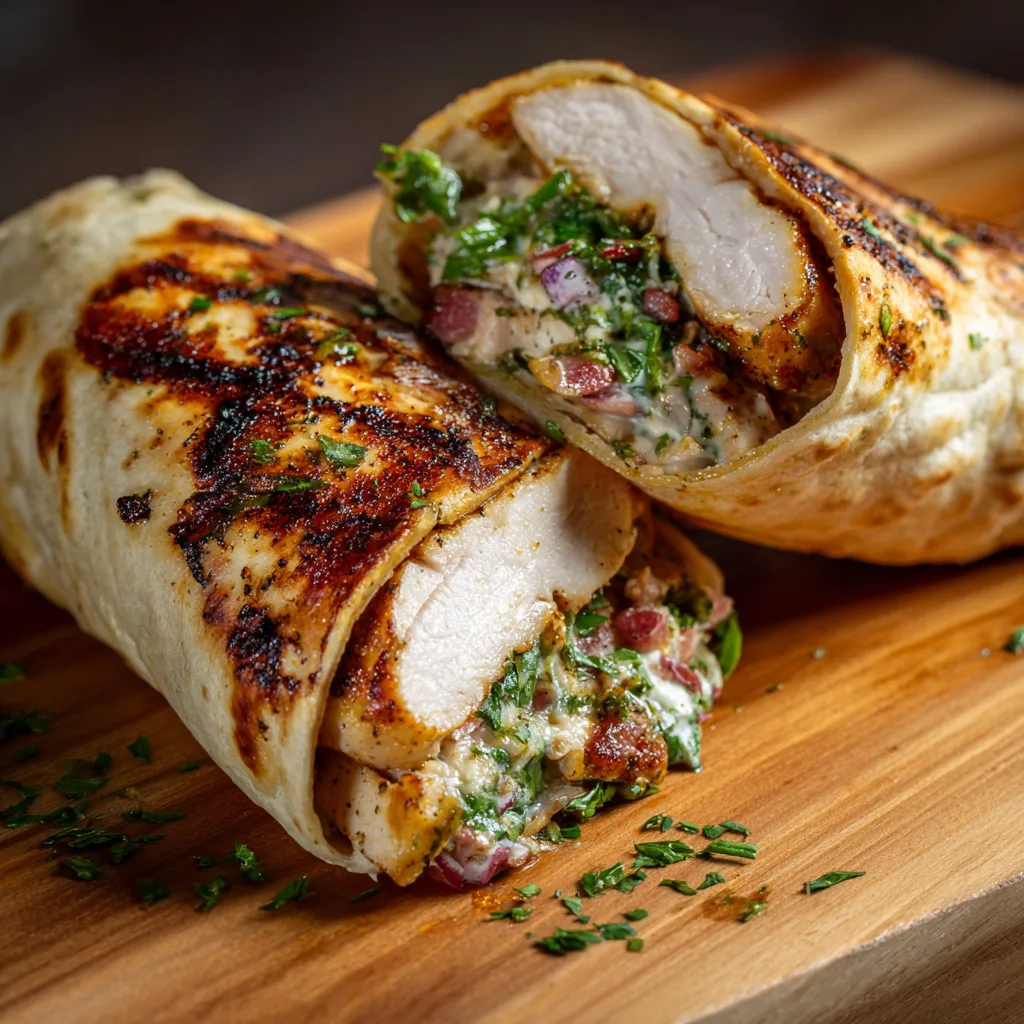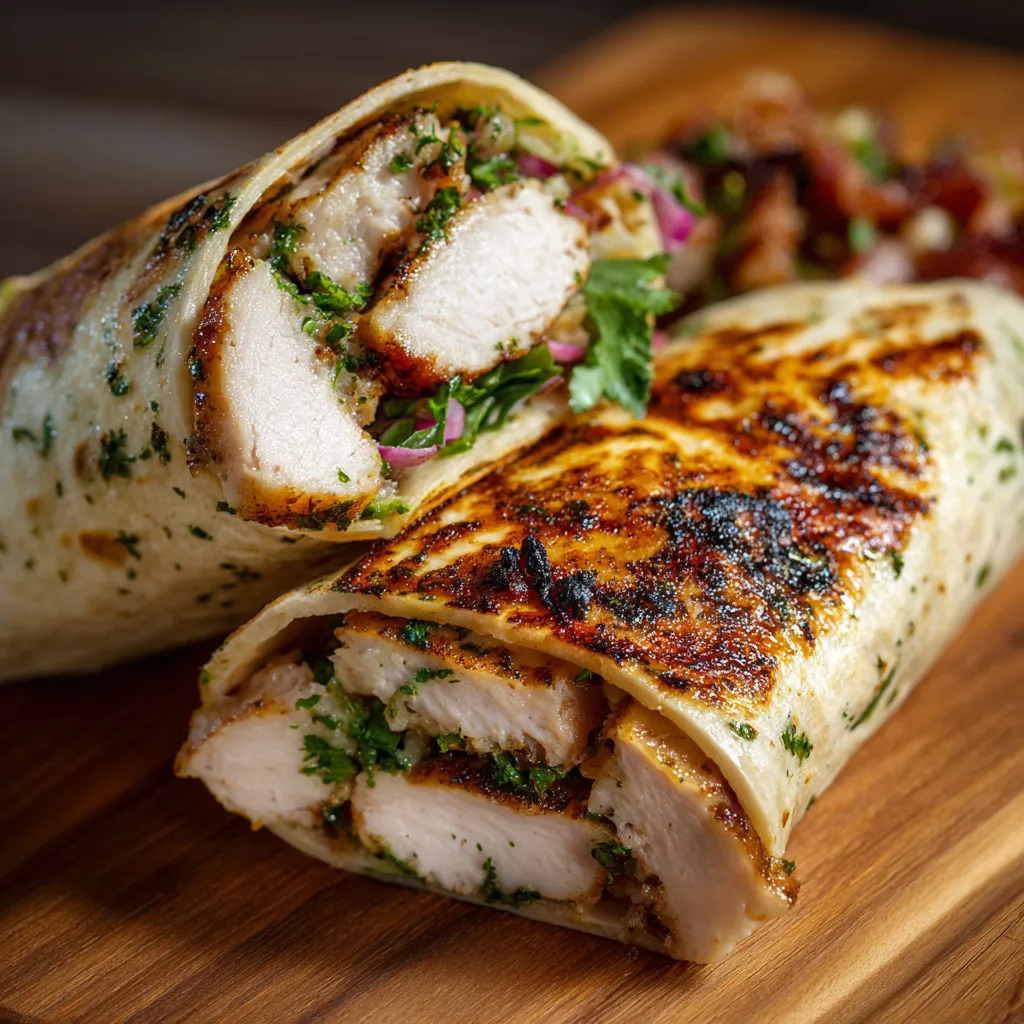Introduction to Oil-Free Cooking
The Rise of Health-Conscious Eating
Over the past decade, health-conscious eating has surged in popularity. People increasingly seek meals that deliver flavor without excess fat. Low-fat and oil-free diets have become staples for those prioritizing heart health, weight management, and overall wellness. Reducing oil intake not only lowers calories but also supports better digestion and sustained energy levels. Modern home cooks and meal preppers now embrace strategies that make nutritious meals both practical and delicious. Transitioning to oil-free cooking allows you to enjoy wholesome meals without sacrificing taste or texture.
What Is a No Oil Pan-Seared Chicken Breast Wrap?
A no oil pan-seared chicken breast wrap is a smart, healthy twist on the classic wrap. It features tender chicken breast, cooked to perfection without oil, wrapped alongside fresh vegetables and flavorful spreads. The chicken achieves a satisfying golden-brown crust using careful searing techniques, avoiding greasy textures. Unlike traditional oil-seared wraps, this method focuses on maximizing natural flavors through seasoning and cooking technique. The result is a lean, protein-packed meal that satisfies cravings while keeping fat content minimal.
Why Choose This Method?
Choosing an oil-free pan-seared wrap offers multiple benefits. First, it reduces overall fat and calorie intake without compromising flavor. Second, seasoning and proper pan-searing enhance the natural taste and juiciness of chicken. Finally, this method caters to diverse dietary needs, from low-fat enthusiasts to those seeking high-protein meals. By adopting this approach, you enjoy a satisfying, wholesome wrap that balances nutrition, taste, and simplicity. It’s an ideal option for anyone looking to make mealtime both healthy and exciting.
Mastering Oil-Free Pan-Seared Chicken
The Science Behind Oil-Free Searing
Achieving a golden-brown crust without oil requires precision. High heat is essential to create a Maillard reaction, which produces rich color and deep flavor on the chicken’s surface. Timing plays a critical role; cooking too long can dry out the meat, while undercooking leaves it raw. Preheating the pan ensures even heat distribution, preventing sticking and promoting a crisp exterior. Using a dry skillet allows the chicken’s natural juices to form a light, flavorful coating. With attention to temperature and timing, you can replicate the taste and texture of traditional searing while keeping the dish low-fat and healthy.
Preparing Chicken for Searing
Choosing the right chicken cut is the first step. Boneless, skinless chicken breasts are ideal for oil-free searing because they cook evenly and remain tender. To ensure uniform cooking, pound the chicken to an even thickness, about half an inch, which prevents uneven doneness. Proper seasoning elevates the flavor without adding fat. Dry rubs, such as garlic powder, paprika, and black pepper, create a savory crust, while marinades made from lemon juice, herbs, or yogurt tenderize the meat and infuse additional taste. Preparing chicken thoughtfully sets the foundation for a perfectly cooked, juicy wrap.
Choosing the Right Cookware
Selecting the right pan is essential for successful oil-free cooking. Non-stick pans minimize sticking, making them convenient for lean proteins. Cast iron offers superior heat retention and can produce a slightly crispier exterior, though it requires careful preheating. Regardless of the pan type, always preheat it over medium heat for several minutes before adding chicken. This step ensures even cooking and prevents moisture from causing sticking. A well-preheated pan locks in juices, giving the chicken a satisfying texture without relying on added fats. Investing in the right cookware elevates your technique and produces consistent, flavorful results.
Crafting the Perfect Chicken Wrap
Selecting the Ideal Wrap Base
Choosing the right wrap forms the foundation of a satisfying meal. Whole wheat tortillas provide fiber and a hearty texture, while spinach wraps add a subtle vegetable flavor and appealing color. Gluten-free options cater to those with sensitivities, and crisp lettuce leaves offer a low-carb, refreshing alternative. When selecting a base, consider dietary preferences, portion size, and flavor balance. The wrap should support the fillings without tearing or overpowering the chicken. Balancing health and taste ensures every bite is enjoyable, nutritious, and filling. Selecting the proper base is the first step in building a wrap that delights both the eyes and the palate.
Complementary Fillings and Toppings
Fresh vegetables elevate flavor, texture, and nutrition. Crisp lettuce, juicy tomatoes, crunchy cucumbers, and sweet bell peppers provide a refreshing contrast to warm chicken. Cheese adds creaminess; options like shredded cheddar or mozzarella work well, and dairy-free alternatives suit those avoiding lactose. Flavorful spreads and sauces enhance taste without adding unnecessary fat. Hummus, Greek yogurt, mashed avocado, or oil-free dressings bring moisture, tang, and richness. Combining fresh produce, cheese, and sauces ensures a balanced mix of textures and flavors. These ingredients harmonize, creating a wrap that’s flavorful, satisfying, and visually appealing.
Layering for Flavor and Texture
Proper layering enhances every bite. Start with a thin layer of sauce to prevent dryness, then add vegetables for crunch. Position the chicken on top, allowing it to remain the wrap’s centerpiece. Cheese can be added next for a creamy layer, followed by lighter vegetables to maintain structure. Folding requires technique: tuck the sides in and roll tightly to prevent ingredients from spilling. Press lightly to seal the wrap. Strategic layering balances taste, texture, and visual appeal. A well-assembled wrap ensures consistent flavor in every bite while maintaining a neat, easy-to-handle structure.
Health Benefits and Customization
Nutritional Advantages of Oil-Free Cooking
Cooking without oil significantly reduces calorie and fat intake while maintaining flavor. Lean proteins like chicken retain their natural moisture and nutrients when seared properly. Vegetables preserve vitamins and minerals that high-fat cooking methods might diminish. Oil-free cooking encourages nutrient-dense meals without compromising taste. It also supports heart health and weight management by limiting unnecessary fats. By focusing on fresh ingredients and careful cooking techniques, you achieve a wholesome, satisfying meal that fuels your body efficiently.
Adapting the Wrap for Dietary Needs
No oil pan-seared wraps are highly adaptable for various dietary preferences. Gluten-free eaters can substitute tortillas with rice paper or crisp lettuce leaves, creating a light and satisfying alternative. Vegetarian or plant-based diets benefit from replacing chicken with firm tofu or tempeh, which sear beautifully and absorb seasonings well. Low-carb options include cauliflower tortillas or simply skipping the wrap entirely while enjoying the seasoned chicken and vegetables as a salad. These adjustments ensure that the wrap suits multiple lifestyles while maintaining taste and texture.
Flavor Enhancements
Herbs and spices amplify flavor without adding calories. Fresh basil, cilantro, parsley, or oregano can brighten the wrap, while paprika, cumin, or chili powder adds warmth and depth. International flavor profiles elevate variety: Mediterranean-inspired wraps include olives and feta, Mexican versions feature avocado and salsa, and Asian-style wraps incorporate sesame seeds, soy, or ginger. These enhancements keep meals exciting, encouraging repeated enjoyment and dietary adherence. Thoughtful seasoning transforms a simple wrap into a flavorful, nutrient-rich meal that appeals to all taste preferences.
Frequently Asked Questions
Can I achieve a crispy texture without oil?
Yes, a crispy crust is achievable without oil. Preheat your pan thoroughly over medium heat to ensure even cooking. Using a dry rub made from spices like paprika, garlic powder, and black pepper creates a flavorful, lightly crisp exterior. Avoid moving the chicken too soon; letting it sear undisturbed allows natural juices to form a golden crust. This technique delivers a satisfying texture similar to traditional oil-seared chicken while keeping the dish low-fat and healthy.
What if my chicken breasts are uneven in thickness?
Uneven chicken breasts cook inconsistently, leaving parts overcooked while others remain underdone. To prevent this, pound each breast to a uniform thickness, ideally about half an inch. This ensures even heat distribution and faster cooking. Uniform pieces also make slicing and layering in the wrap easier, resulting in a more visually appealing and consistent meal.
Are there oil-free alternatives to traditional wraps?
Yes, several oil-free alternatives work well for healthy wraps. Crisp lettuce leaves or collard greens offer a refreshing, low-calorie option. Gluten-free tortillas made from rice flour, chickpea flour, or other plant-based ingredients cater to dietary restrictions while maintaining structural integrity. These alternatives keep the wrap light, nutritious, and flavorful without relying on added fats.
How can I prevent the chicken from sticking to the pan?
To avoid sticking, use a well-preheated non-stick or cast iron skillet. Ensure the pan reaches medium heat before adding the chicken. Pat the chicken dry before cooking to remove excess moisture, which reduces sticking and promotes even browning. With these simple steps, you achieve a smooth cooking process and a golden, juicy result every time.
Can I prepare the wraps in advance?
Yes, but careful storage preserves freshness. Keep the cooked chicken, vegetables, and sauces separate until assembly. Store each component in airtight containers in the refrigerator for up to two days. Assemble the wraps just before serving to maintain crisp textures and optimal flavor. This method ensures convenience without compromising taste or quality.




